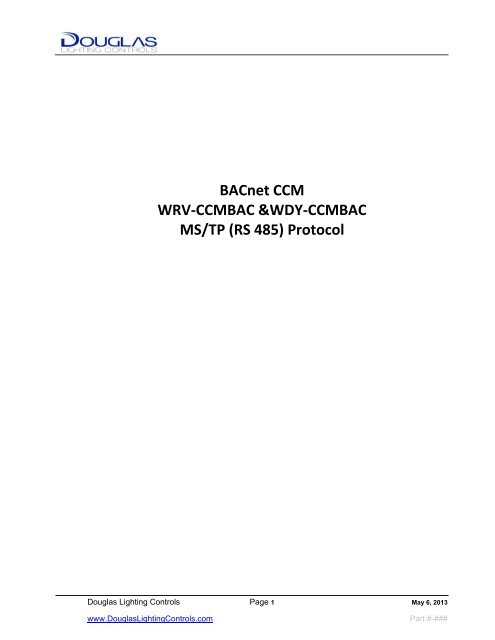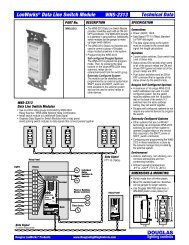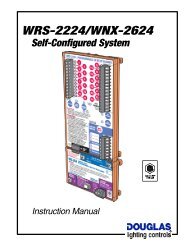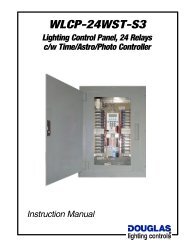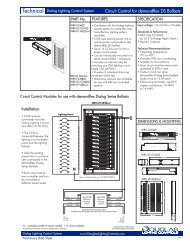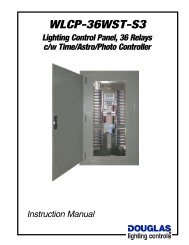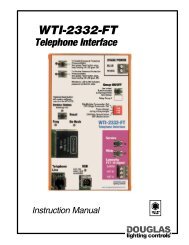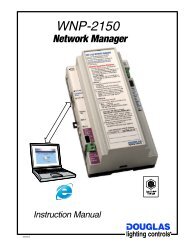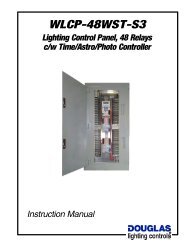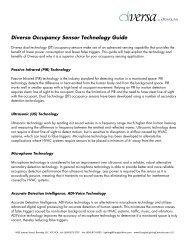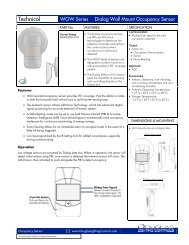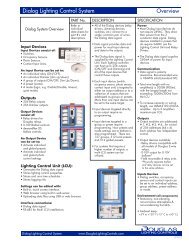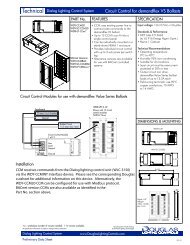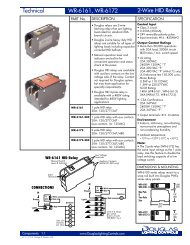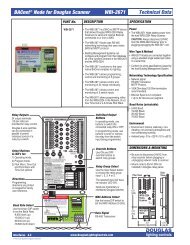BACnet CCM Manual - Douglas Lighting Control
BACnet CCM Manual - Douglas Lighting Control
BACnet CCM Manual - Douglas Lighting Control
You also want an ePaper? Increase the reach of your titles
YUMPU automatically turns print PDFs into web optimized ePapers that Google loves.
<strong>BACnet</strong> <strong>CCM</strong><br />
WRV‐<strong>CCM</strong>BAC &WDY‐<strong>CCM</strong>BAC<br />
MS/TP (RS 485) Protocol<br />
<strong>Douglas</strong> <strong>Lighting</strong> <strong>Control</strong>s Page 1 May 6, 2013<br />
www.<strong>Douglas</strong><strong>Lighting</strong><strong>Control</strong>s.com Part #-###
Contents<br />
1 Purpose 4<br />
2 Operational Overview 4<br />
3 Daylight Harvesting / Zoning 4<br />
3.1.1 Circuit <strong>Control</strong> Module (<strong>CCM</strong>) Functionality .......................................................................................... 4<br />
3.1.2 Circuit <strong>Control</strong> Module Configuration with Binary Value Options ......................................................... 5<br />
3.2 The Commissioning Process .......................................................................................................................... 5<br />
3.2.1 Node ID Commissioning ......................................................................................................................... 5<br />
3.3 Timing Considerations ................................................................................................................................... 6<br />
3.3.1 Processor Watch‐Dog Timer .................................................................................................................. 6<br />
3.3.1.1 Heartbeat Timeout ........................................................................................................................ 6<br />
3.3.1.2 Power Cycling ................................................................................................................................. 6<br />
3.4 Operating Level .............................................................................................................................................. 6<br />
3.4.1 Fade‐Rate ............................................................................................................................................... 6<br />
3.4.2 Fade Time .............................................................................................................................................. 6<br />
3.5 Relay State ..................................................................................................................................................... 6<br />
3.6 LED States ...................................................................................................................................................... 7<br />
3.6.1 Red LED .................................................................................................................................................. 7<br />
3.6.2 Green LED .............................................................................................................................................. 7<br />
3.6.3 Yellow LED .............................................................................................................................................. 7<br />
3.6.4 Alarm States ........................................................................................................................................... 7<br />
3.6.5 <strong>CCM</strong> Error Codes .................................................................................................................................... 8<br />
3.7 Processor Temperature ................................................................................................................................. 8<br />
3.8 Configuration Parameters ............................................................................................................................. 8<br />
3.8.1 Minimum Commissioned Operating‐Level ............................................................................................ 9<br />
3.8.2 Maximum Commissioned Operating‐Level ............................................................................................ 9<br />
3.8.3 Default Fade Rate .................................................................................................................................. 9<br />
3.8.4 Default Power Level ............................................................................................................................... 9<br />
3.8.5 Default Relay State ................................................................................................................................ 9<br />
3.9 Physical Layer ................................................................................................................................................. 9<br />
3.9.1 Vendor ID ............................................................................................................................................... 9<br />
3.9.2 BIBB Support .......................................................................................................................................... 9<br />
3.9.3 Alarms .................................................................................................................................................. 10<br />
4 Objects Supported 11<br />
4.1.1 AI Properties Supported ...................................................................................................................... 13<br />
4.1.2 AV Properties Supported ..................................................................................................................... 13<br />
4.1.3 AO Properties Supported ..................................................................................................................... 14<br />
4.1.4 BV Properties Supported ..................................................................................................................... 15<br />
4.1.5 FI Properties Supported ....................................................................................................................... 15<br />
4.1.6 MSI Properties Supported ................................................................................................................... 15<br />
4.1.7 MSV Properties Supported .................................................................................................................. 15<br />
4.1.8 Non‐Volatile Storage ............................................................................................................................ 16<br />
4.1.9 Commandability ................................................................................................................................... 16<br />
4.1.10 Segmentation ....................................................................................................................................... 16<br />
4.1.11 Configuration ....................................................................................................................................... 16<br />
4.1.12 Cloning ................................................................................................................................................. 16<br />
4.1.13 Default Power Level, MinCommissioned Level, MaxCommissioned Level .......................................... 16<br />
<strong>Douglas</strong> <strong>Lighting</strong> <strong>Control</strong>s Page 2 May 6, 2013<br />
Page 2 of 30<br />
www.<strong>Douglas</strong><strong>Lighting</strong><strong>Control</strong>s.com Part #-###
4.1.14 Heartbeat ............................................................................................................................................. 16<br />
4.1.15 Setting the MAC address and Baud rate .............................................................................................. 17<br />
5 Factory Default Values 17<br />
5.1 Fade‐Time .................................................................................................................................................... 19<br />
5.2 Fade‐Rate (0‐126 sec) .................................................................................................................................. 19<br />
5.3 Scene Arrays ................................................................................................................................................ 20<br />
6 Appendices 21<br />
6.1 RS‐485 Cable wiring diagram ....................................................................................................................... 21<br />
6.2 Serial Number .............................................................................................................................................. 22<br />
6.3 Software and Hardware Version Numbers .................................................................................................. 22<br />
6.4 Fade Rate Table ........................................................................................................................................... 22<br />
6.5 Device Re‐Programming / Boot Loader Code .............................................................................................. 25<br />
6.5.1 Example Programming Session ............................................................................................................ 25<br />
7 Glossary 26<br />
8 Protocol Implementation Conformance Statement 27<br />
Change History<br />
Revision Comments<br />
1.0 Original Release<br />
1.1 Revised section 3.4 and added BV6 and BV7<br />
<strong>Douglas</strong> <strong>Lighting</strong> <strong>Control</strong>s Page 3 May 6, 2013<br />
Page 3 of 30<br />
www.<strong>Douglas</strong><strong>Lighting</strong><strong>Control</strong>s.com Part #-###
1 Purpose<br />
This document describes the <strong>BACnet</strong> communications protocol for the <strong>Douglas</strong> <strong>Lighting</strong> <strong>Control</strong>s (DLC) <strong>BACnet</strong><br />
<strong>CCM</strong> <strong>Control</strong>ler (WRV‐<strong>CCM</strong>BAC & WDY‐<strong>CCM</strong>BAC)). This product provides a software‐implemented network<br />
interface between <strong>BACnet</strong> client devices and <strong>CCM</strong>‐BAC monitoring points. Once the module is configured, the<br />
<strong>CCM</strong>‐BAC controller is a native <strong>BACnet</strong> controller device with MS/TP capabilities.<br />
The <strong>CCM</strong>‐BAC communicates with other <strong>BACnet</strong> devices and maintain proactive status of various real‐time<br />
measurements. Information is published for use by <strong>BACnet</strong> devices and a limited number of parameters can be<br />
changed by <strong>BACnet</strong> client devices and conveyed to the controller. The <strong>CCM</strong> controller is used in the following<br />
products: WRV‐<strong>CCM</strong>BAC & WDY‐<strong>CCM</strong>BAC.<br />
2 Operational Overview<br />
This section provides a high level operational overview in the following sections:<br />
Daylight Harvesting / Zoning<br />
The Commissioning Process<br />
Timing Considerations<br />
Operating Level<br />
Refer to the other sections of this document for more detailed information.<br />
3 Daylight Harvesting / Zoning<br />
To support Daylight Harvesting (DH), this protocol supports the <strong>CCM</strong> addressing ballasts in three different Zones<br />
– Zone‐A, Zone‐B, and Zone‐C. Ballasts addressed prior to DH are all in Zone‐A. The <strong>BACnet</strong> objects relating to<br />
setting the dim level include:<br />
Desired Power Level<br />
Fade Rate or Time<br />
Scene Index<br />
Fade Index.<br />
Operations not related to dimming are addressed to Zone‐A. In particular, relay‐on and relay‐off commands are<br />
only valid for Zone‐A. The <strong>CCM</strong> uses an additional zone called Zone‐T to send commands to commission ballasts.<br />
Note that some versions of the <strong>CCM</strong> only support Zone‐A.<br />
3.1.1 Circuit <strong>Control</strong> Module (<strong>CCM</strong>) Functionality<br />
The <strong>CCM</strong>‐BAC <strong>CCM</strong> functionality is similar to the operation of the existing Bacnet and MODBUS units and<br />
includes the following functions:<br />
1. <strong>Control</strong> the power of the ballasts from a Minimum to a Maximum level.<br />
2. Turn power on/off using the relay <strong>CCM</strong>’s internal relay.<br />
3. Ability to gradually change the output power to a new level based on either a rate or a time interval.<br />
4. Support indirect control of power levels and fade rates/times using Scenes and Fade tables.<br />
5. Measurement of circuit Voltage, Current, Power and processor Temperature.<br />
6. Ability to read and write Configuration Data.<br />
<strong>Douglas</strong> <strong>Lighting</strong> <strong>Control</strong>s Page 4 May 6, 2013<br />
Page 4 of 30<br />
www.<strong>Douglas</strong><strong>Lighting</strong><strong>Control</strong>s.com Part #-###
7. Ability to modify default behavior using Binary Value options.<br />
3.1.2 Circuit <strong>Control</strong> Module Configuration with Binary Value Options<br />
The Binary Value (BV’s) Objects are used to modify the default operation of the <strong>CCM</strong> as follows:<br />
1. BV0: Use Fade Time – If set to 0 then the fade rate is used to slew to the new desired power level, and if<br />
set to zero then the fade time is used to slew to the new desired power. The relationship is: Fade Rate =<br />
|Current Power – New Power| / Fade Time<br />
2. BV1: Zero Not Off – The default operation of the <strong>CCM</strong> is to interpret a commanded level of 0% to Zone<br />
A as a command to turn off circuit power using the internal relay. However if BV1 is set to 1 then a<br />
commanded level of 0% is ignored for Zone A and the relay state is controlled by object BV100 (Relay<br />
Output).<br />
3. BV2: Relay output Power‐On – This value is use to set the power‐on state of the relay; 1 for On (power<br />
to circuit / default) and 0 for Off (relay is open).<br />
4. BV3: Exclude Levels – Setting to 1 will cause certain level to be excluded. Only use if issued related to<br />
false locking of ballast levels is encountered. The following level requests will be modified as listed:<br />
4.1. 81% ‐‐> 80%<br />
4.2. 87% ‐‐> 86%<br />
4.3. 88% ‐‐> 89%<br />
4.4. 94% ‐‐>93%<br />
5. BV4: Alternate Reset – Warning: USE WITH CARE! Writing to this variable will cause the <strong>CCM</strong> to do a<br />
processor reset.<br />
6. BV5: Alarm Status – Read as 1 if an alarm condition is set. The reason for the alarm is specified in MSI1.<br />
Write either 0 or 1 to BV5 to clear the alarm condition. However, if the alarm condition persists, then<br />
the value will immediately be set back to 1 by the <strong>CCM</strong> firmware.<br />
7. BV6‐BV7: Reserved for future use<br />
8. BV100: Relay Output – This variable is used to open (0) or close (1) the relay contacts if BV1 =1;<br />
otherwise this variable is ignored<br />
3.2 The Commissioning Process<br />
During the Commissioning Process, the MAC Address, Device ID, Baud rate, and Heartbeat timeout are stored in<br />
non‐volatile (Flash) memory in the <strong>CCM</strong>.<br />
<strong>Douglas</strong> <strong>Lighting</strong> provides a handheld Commissioning Tool; the <strong>CCM</strong>‐BAC‐PRG, that will allows users to configure<br />
the module.<br />
A system integrator may alternately use <strong>BACnet</strong> commands to set the values of the objects in section 4.<br />
3.2.1 Node ID Commissioning<br />
All <strong>Douglas</strong> <strong>Lighting</strong> <strong>CCM</strong>s are factory programmed with MAC (base) address set to 0. This base address is added<br />
to the MAC address set by the DIP switches to set the MAC address of the <strong>CCM</strong>. For hardware that does not<br />
contain switches, the MAC address is set by the desired MAC Address object. When a customer places an order<br />
for a Panel containing <strong>CCM</strong>s, the MAC Addresses are custom programmed into the <strong>CCM</strong>s according to the sales<br />
order, or with default MAC Addresses according to the location of the <strong>CCM</strong> within the Panel.<br />
<strong>Douglas</strong> <strong>Lighting</strong> <strong>Control</strong>s Page 5 May 6, 2013<br />
Page 5 of 30<br />
www.<strong>Douglas</strong><strong>Lighting</strong><strong>Control</strong>s.com Part #-###
3.3 Timing Considerations<br />
3.3.1 Processor Watch‐Dog Timer<br />
The <strong>CCM</strong> contains a Watch Dog Timer which must be reset every 256ms by the <strong>CCM</strong>, or the <strong>CCM</strong> processor will<br />
be Reset. This timer prevents the code from hanging due to software bugs or unexpected conditions. The Alarm‐<br />
State and Red LED are set if the Watch‐Dog Timer is not reset. The <strong>BACnet</strong> controller has no control over this<br />
timing value.<br />
3.3.1.1 Heartbeat Timeout<br />
The <strong>BACnet</strong> controller must send a command to the RS485 bus every N seconds (usually 90 sec), or the <strong>CCM</strong>s<br />
will command the ballast to go to the Default Operating‐Level. The system ignores a Heartbeat‐Timeout if the<br />
timeout value is zero. Receipt of any valid message will reset the Heartbeat‐Timeout timer, e.g. a NOP command<br />
broadcast to all nodes.<br />
3.3.1.2 Power Cycling<br />
Since the <strong>CCM</strong> does not retain its current Desired Power Levels, e following a loss of AC power, it will be<br />
necessary to re‐send the current Desired Power Levels or Scene Index after a power loss.<br />
3.4 Operating Level<br />
An Operating‐Level command in the range of 0‐100% (1% steps) may be sent to the <strong>CCM</strong>. For the WDY‐<br />
<strong>CCM</strong>BAC, operating level is translated as a command for ballast input power, and is internally restricted to a low<br />
of 34%. For the WRV‐<strong>CCM</strong>BAC, operating level is translated as a command for light output and has no such<br />
restriction. For both systems, the absolute low end operation is determined by ballast capabilities – please refer<br />
to the ballast cut sheets for this information. Additionally, the <strong>CCM</strong> relay will be opened when an operating‐<br />
level of 0 is commanded to Zone‐A, resulting in a power interruption to the ballast loads. Both <strong>CCM</strong> types<br />
support three Zones (A, B, and C), however all status and data such as temperature, voltage, and current are<br />
associated with Zone‐A.<br />
3.4.1 Fade‐Rate<br />
This value is the delay in seconds between reductions or increases in operating levels applying to all transitions.<br />
Since there are 100 operating‐ levels, it is the time it takes to fade (1/100) or 1.0% of full scale. For example, if<br />
the fade rate is 10 and the users change the operating level from 100% to 50%, then the time to fade is 10 x 50 =<br />
500 seconds. A Fade‐Rate of 0 indicates that the Operating‐Level should be immediately set. A Fade‐Rate of 127<br />
(0x7F) indicates that the <strong>CCM</strong> should use the Default programmed Fade‐Rate for that node.<br />
Note: It may take an additional 20 to 30 seconds for the lamp to respond to a change in level due to the inherent<br />
“lag” in communications between the <strong>CCM</strong> and the ballast.<br />
3.4.2 Fade Time<br />
With the appropriate Configuration Data State‐bit set, the user can specify the Fade Time instead of the fade<br />
rate. The Fade Time is the time it will take to achieve the next commanded level. This time is only approximate<br />
as the <strong>CCM</strong> converts the Fade Time into an equivalent Fade Rate that is used internally in the <strong>CCM</strong> to fade to the<br />
desired level. The maximum Fade Time is 127 seconds. Use the Fade‐Rate if longer time delays are required.<br />
3.5 Relay State<br />
0 – “Yellow,” meaning Red and Green, LED is ON and Relay contacts are open<br />
<strong>Douglas</strong> <strong>Lighting</strong> <strong>Control</strong>s Page 6 May 6, 2013<br />
Page 6 of 30<br />
www.<strong>Douglas</strong><strong>Lighting</strong><strong>Control</strong>s.com Part #-###
3.6 LED States<br />
1 – Green LED is on and Relay contacts are closed, and the lights have power<br />
There is a single bi‐color LED visible on the <strong>CCM</strong>: The colors provided are Red, Green, and Yellow. The use of<br />
each LED color is as follows:<br />
3.6.1 Red LED<br />
When lit this indicates an Alarm or Fault condition. The LED will blink the associated Error‐Code when the Alarm<br />
Status bit is set. The Red LED also illuminates upon a Reset or Power‐On of the <strong>CCM</strong> processor. The Red LED<br />
turns off after receipt of a valid command. This LED will blink at a 1/4 second rate to indicate an alarm condition<br />
with a pause of 1 second between blinks. The number of blinks indicates the Error‐Code. The Red LED is also on<br />
during <strong>CCM</strong> programming over an RS485 link.<br />
3.6.2 Green LED<br />
Indicates that the <strong>CCM</strong> has power and is operating normally and that the relay contacts are closed and the lamps<br />
are lit. This LED may blink as a diagnostic aid to help locate the <strong>CCM</strong> in a panel.<br />
3.6.3 Yellow LED<br />
Indicates that power is present, but the <strong>CCM</strong> Relay contacts are open and that the ballasts are not receiving A/C<br />
power. The indicator is a bi‐color Red/Green LED with both colors illuminated. (Yellow = Red + Green).<br />
3.6.4 Alarm States<br />
An alarm condition indicates that an internal error has occurred. This alarm will also be set following initial<br />
power‐up of the <strong>CCM</strong> slave. The Red LED will blink an Error Code whenever there is an Alarm condition. If there<br />
are no internal errors, the alarm clears with any subsequent valid command received. If the alarm bit does not<br />
clear following an Operating‐level change command, it may indicate a hardware failure.<br />
Monitoring of the alarm state will allow the HOST to recognize that an individual <strong>CCM</strong> has lost power. Since the<br />
<strong>CCM</strong> does not retain its current Operating‐level state following a loss of AC power, it will be necessary to re‐send<br />
the current Operating‐level or scene recall state.<br />
<strong>Douglas</strong> <strong>Lighting</strong> <strong>Control</strong>s Page 7 May 6, 2013<br />
Page 7 of 30<br />
www.<strong>Douglas</strong><strong>Lighting</strong><strong>Control</strong>s.com Part #-###
3.6.5 <strong>CCM</strong> Error Codes<br />
The Error reported in MSI1 gives additional information about the Alarm State.<br />
They correspond to a Red LED that blinks differently according to the Alarm States, except for an Error Code<br />
Value of one that displays a Solid Red LED.<br />
Values:<br />
0 NO_ERR<br />
1 POWER_ON or WDT RESET (Solid RED – does not blink)<br />
2 HEART_BEAT_TIMEOUT<br />
3 OVER_TEMPERATURE<br />
4 ERASE_ERROR<br />
5 DATA_OVERRUN<br />
6 BAD_RELAY_EVENT<br />
7 BAD_COMMAND<br />
8 BAD_TIMER_UNITS<br />
9 WRITE_ERROR<br />
10 MISSING ZERO CROSSING<br />
11 LOW_VOLTAGE_DETECT_RESET,<br />
12 SERIAL_NUMBER_PROGRAMMING_FAULT<br />
13 PROGRAM_CHECKSUM_ERROR<br />
14 FACTORY_CHECKSUM_ERROR<br />
15 CONFIG_CHECKSUM_ERROR<br />
3.7 Processor Temperature<br />
This optional value may be present if supported by the microprocessor used in the <strong>CCM</strong>. The processor<br />
temperature reading returns the internal core temperature of the embedded microcontroller inside the <strong>CCM</strong><br />
unit.<br />
3.8 Configuration Parameters<br />
The <strong>CCM</strong> has a limited amount of local FLASH memory used to retain parameters between power cycles without<br />
the need for reloading these parameters by the <strong>BACnet</strong> controller. This data is stored in “Write Once” FLASH<br />
memory. The configuration data is mapped into individual <strong>BACnet</strong> objects.<br />
The following values are stored as Configuration Data (with recommended default values):<br />
Node ID (uninitialized value is 0xFF)<br />
Min Commissioned Operating‐Level (1 byte – default is 50%)<br />
Max Commissioned Operating‐Level (1 byte – default is 100%)<br />
Default Fade‐Rate (1 byte – default is 10; 0‐127 seconds / 1% change)<br />
Default Power Level (default is 80%)<br />
Default Relay State on power‐up (default is 1 = closed contacts)<br />
Heartbeat timeout in seconds (default is 90 seconds)<br />
Operating‐Level Scene array (16 bytes)<br />
Fade‐Rate Scene array (8 bytes)<br />
Other data use by program internally<br />
<strong>Douglas</strong> <strong>Lighting</strong> <strong>Control</strong>s Page 8 May 6, 2013<br />
Page 8 of 30<br />
www.<strong>Douglas</strong><strong>Lighting</strong><strong>Control</strong>s.com Part #-###
3.8.1 Minimum Commissioned Operating‐Level<br />
The Min‐Commissioned Operating‐Level specifies the minimum commanded operating‐level. This value is<br />
normally set during the commissioning process. If a commanded level is less than this value, then it is set to the<br />
Minimum Commissioned Operating Level. This value is specified by the Max_Pres_Value property of the Desired<br />
Power Level objects.<br />
3.8.2 Maximum Commissioned Operating‐Level<br />
The Max‐Commissioned Operating‐Level specifies the maximum commanded operating‐level. This value is<br />
normally set during the commissioning process. If a commanded level is greater than this value, then it is set to<br />
the Maximum Commissioned Operating Level. This value is specified by the Min_Pres_Value property of the<br />
Desired Power Level objects.<br />
3.8.3 Default Fade Rate<br />
After a <strong>CCM</strong> processor reset, the ballasts are set to the Default Fade Rate at the Default Power Level.<br />
3.8.4 Default Power Level<br />
After a <strong>CCM</strong> processor reset, the ballasts are set to the Default Power Level at the Default Fade Rate.<br />
3.8.5 Default Relay State<br />
The Default Relay State is normally set to 1 (On) to specify closed contacts or power applied to the lamp circuits.<br />
This is the state of the Relay during power‐up of the <strong>CCM</strong>.<br />
.<br />
3.9 Physical Layer<br />
The physical layer of the communication link is RS‐485 with the following specifications.<br />
Baud Rate: 38400 Bits per second<br />
Data Bits: 8<br />
Parity: None<br />
Stop Bits: 1<br />
Flow <strong>Control</strong>: None<br />
RS232 Signaling is also supported, but this requires the use of an external signal converter to convert RS232<br />
signals to RS485 signals. RS232 Signaling may need to use hardware flow‐control to work properly with the<br />
external signal converter. Any <strong>CCM</strong> slaves connect together with straight‐through RJ45 network cables. See<br />
Appendix 6.1 for more information.<br />
Baud Rates supported are 9600, 19200, 38400, 57600, 76800 and 115200 baud<br />
3.9.1 Vendor ID<br />
The vendorID is 559. The Device Instances defaults to 559000. When WriteProperty service requests using the<br />
wildcard Device instance are received, the Device Object_Identifier may be written with a new device instance<br />
which is retained in FLASHmemory. Inter‐character Delay<br />
3.9.2 BIBB Support<br />
The <strong>CCM</strong>‐BAC generally behaves as a B‐ASC type profile server. The following specific BIBBs are supported per<br />
their relevant definitions in Annex K to <strong>BACnet</strong>:<br />
<strong>Douglas</strong> <strong>Lighting</strong> <strong>Control</strong>s Page 9 May 6, 2013<br />
Page 9 of 30<br />
www.<strong>Douglas</strong><strong>Lighting</strong><strong>Control</strong>s.com Part #-###
DS‐RP‐B, DS‐WP‐B, DS‐RPM‐B, DM‐DDB‐B, DM‐DOB‐B, DM‐DCC‐B.<br />
3.9.3 Alarms<br />
Although the <strong>CCM</strong>‐BAC supports the ability to indicate various alarm conditions through value changes in<br />
properties of several of its objects, it does NOT generate <strong>BACnet</strong> Event Notifications.<br />
<strong>Douglas</strong> <strong>Lighting</strong> <strong>Control</strong>s Page 10 May 6, 2013<br />
Page 10 of 30<br />
www.<strong>Douglas</strong><strong>Lighting</strong><strong>Control</strong>s.com Part #-###
4 Objects Supported<br />
The <strong>CCM</strong>‐BAC supports 176 <strong>BACnet</strong> standard objects that represent the controller itself. Properties are<br />
Readonly, Writable in RAM, or Writeable in Flash. Writeable properties are also readable.<br />
DEx Object_Identifier default to DE559000 F<br />
Object_Name Up to 64 characters F<br />
Object_Type DEVICE R<br />
System_Status OPERATIONAL or<br />
NON_OPERATIONAL<br />
R<br />
Vendor_Name “<strong>Douglas</strong> <strong>Lighting</strong> <strong>Control</strong>s<br />
Inc.”<br />
R<br />
Vendor_Identifier 559 R<br />
Model_Name “WRV‐<strong>CCM</strong>BAC or WDY‐<br />
<strong>CCM</strong>BAC”<br />
R<br />
Firmware_Revision “aa|bb|cc|dd” SN, Fmw,<br />
Hdw, Boot ver<br />
R<br />
Application_Software_Version “1.00” R<br />
Description Up to 64 characters F<br />
Protocol_Version 1 R<br />
Protocol_Revision 12 R<br />
Protocol_Services_Supported { readProperty, writeProperty,<br />
readPropertyMultiple,<br />
deviceCommunication<strong>Control</strong>,<br />
who‐Has, who‐Is, i‐Am,<br />
unconfirmedCOVNotification,<br />
reinitializeDevice,<br />
atomicReadFile,<br />
atomicWriteFile }<br />
R<br />
Protocol_Object_Types_Supported { AnalogInput, AnalogOutput,<br />
AnalogValue, BinaryValue,<br />
Device, MultistateInput,<br />
MultistateValue, Positive<br />
Integer Value }<br />
R<br />
Object_List<br />
R<br />
DEx, AI1, AI2, AI3, AI4, AI100, AI200, AI300, AO100, AO200, AO300, AV0,<br />
AV1, AV2, AV3, AV4, AV5, AV100, AV101, AV102, AV1100, AV1101, AV1102,<br />
AV1103, AV1104, AV1105, AV1106, AV1107, AV1108, AV1109, AV1110,<br />
AV1111, AV1112, AV1113, AV1114, AV1115, AV1116, AV1117, AV1118,<br />
AV1119, AV1120, AV1121, AV1122, AV1123, AV1124, AV1125, AV1126,<br />
AV1127, AV1128, AV2100, AV2101, AV2102, AV2103, AV2104, AV2105,<br />
AV2106, AV2107, AV2108, AV2109, AV2110, AV2111, AV2112, AV2113,<br />
AV2114, AV200, AV201, AV202, AV1200, AV1201, AV1202, AV1203, AV1204,<br />
AV1205, AV1206, AV1207, AV1208, AV1209, AV1210, AV1211, AV1212,<br />
AV1213, AV1214, AV1215, AV1216, AV1217, AV1218, AV1219, AV1220,<br />
<strong>Douglas</strong> <strong>Lighting</strong> <strong>Control</strong>s Page 11 May 6, 2013<br />
Page 11 of 30<br />
www.<strong>Douglas</strong><strong>Lighting</strong><strong>Control</strong>s.com Part #-###
AV1221, AV1222, AV1223, AV1224, AV1225, AV1226, AV1227, AV1228,<br />
AV2200, AV2201, AV2202, AV2203, AV2204, AV2205, AV2206, AV2207,<br />
AV2208, AV2209, AV2210, AV2211, AV2212, AV2213, AV2214, AV300,<br />
AV301, AV302, AV1300, AV1301, AV1302, AV1303, AV1304, AV1305,<br />
AV1306, AV1307, AV1308, AV1309, AV1310, AV1311, AV1312, AV1313,<br />
AV1314, AV1315, AV1316, AV1317, AV1318, AV1319, AV1320, AV1321,<br />
AV1322, AV1323, AV1324, AV1325, AV1326, AV1327, AV1328, AV2300,<br />
AV2301, AV2302, AV2303, AV2304, AV2305, AV2306, AV2307, AV2308,<br />
AV2309, AV2310, AV2311, AV2312, AV2313, AV2314, BV0, BV1, BV2, BV3,<br />
BV4, BV5, BV6, BV7, BV100, FI1, FI2, MSI1, MSV1, PIV1<br />
Max_APDU_Length_Accepted 480 R<br />
Segmentation_Supported NONE R<br />
APDU_Timeout 3000 default R<br />
Number_Of_APDU_Retries 1 default R<br />
Device_Address_Binding always empty R<br />
Database_Revision X R<br />
objid name notes R/W<br />
AI1 Actual Power Level measured feedback R<br />
AI2 Temperature Internal processor temp R<br />
AI3 Voltage measured load voltage R<br />
AI4 Current measured load current R<br />
AI100 Current Power Level A 0..100 R<br />
AI200 Current Power Level B 0..100 R<br />
AI300 Current Power Level C 0..100 R<br />
AO100 Desired Power Level A Dimmer<br />
setpoint (commandable)<br />
W<br />
AO200 Desired Power Level B dimmer<br />
setpoint (commandable)<br />
W<br />
AO300 Desired Power Level C dimmer<br />
setpoint (commandable)<br />
W<br />
AV0 DesiredMACAddress 0..127 F<br />
AV1 DesiredBaudrate 9600, 19200… F<br />
AV2 Heartbeat Time 90 seconds, 0=off F<br />
AV3 Reserved For Future Use Only. F<br />
AV4 Reserved For Future Use Only. F<br />
AV5 Reserved For Future Use Only. F<br />
AV100 Fade Rate A 0..127 F<br />
AV101 Fade Time A 0..127 F<br />
AV102 Scene Index A dimmer setpoint W<br />
AV103 Fade Index A dimmer setpoint W<br />
AV11xx Scene[xx] A where xx=0..28 0..100 F<br />
AV21xx Fade[xx] A where xx=0..14 0 to 127 F<br />
AV200 Fade Rate B 0..127 F<br />
AV201 Fade Time B 0..127 F<br />
AV202 Scene Index B dimmer setpoint W<br />
AV203 Fade Index B dimmer setpoint W<br />
AV12xx Scene[xx] B where xx=0..28 0..100 F<br />
AV22xx Fade[xx] B where xx=0..14 0 to 127 F<br />
AV300 Fade Rate C 0..127 F<br />
<strong>Douglas</strong> <strong>Lighting</strong> <strong>Control</strong>s Page 12 May 6, 2013<br />
Page 12 of 30<br />
www.<strong>Douglas</strong><strong>Lighting</strong><strong>Control</strong>s.com Part #-###
AV301 Fade Time C 0..127 F<br />
AV302 Scene Index C dimmer setpoint W<br />
AV303 Fade Index C dimmer setpoint W<br />
AV13xx Scene[xx] C where xx=0..28 0..100 F<br />
AV23xx Fade[xx] C where xx=0..14 0 to 127 F<br />
BV0 UseFadeTime 0=fade rate, 1=fade time F<br />
BV1 ZeroNotOff F<br />
BV2 Relay Output Power‐On power‐on state for BV100 F<br />
BV3 ExcludeLevels F<br />
BV4 Alternate Reset write 1 to reset W<br />
BV5 Alarm Status / Reset 1 if in alarm; set to 0 or 1 to<br />
clear alarm<br />
W<br />
BV6 LogDimming 1 for demandflex DS ballasts. F<br />
BV7 QuickDim 0 F<br />
BV100 Relay Output alternate command relay<br />
on/off<br />
W<br />
FI1 Configuration Data Block binary up/download image of<br />
parameters<br />
R<br />
FI2 FactoryData R<br />
FI3 <strong>BACnet</strong>Data R<br />
MSI1 Error enumerated error code and<br />
text<br />
R<br />
MSV1 LED 1=off, 2=on, 3=blink W<br />
PIV1 SupervisoryDevice 0..4194303 F<br />
4.1.1 AI Properties Supported<br />
Object_Identifier dword R<br />
Object_Name string F<br />
Object_Type dword R<br />
Present_Value real R<br />
Description string F<br />
Device_Type string R<br />
Status_Flags bitstring R<br />
Event_State dword R<br />
Reliability dword R<br />
Update_Interval dword R<br />
Units dword R<br />
Min_Pres_Value real F<br />
Max_Pres_Value real F<br />
Resolution real R<br />
4.1.2 AV Properties Supported<br />
Object_Identifier dword R<br />
Object_Name string F<br />
Object_Type dword R<br />
Present_Value real W<br />
<strong>Douglas</strong> <strong>Lighting</strong> <strong>Control</strong>s Page 13 May 6, 2013<br />
Page 13 of 30<br />
www.<strong>Douglas</strong><strong>Lighting</strong><strong>Control</strong>s.com Part #-###
Description string F<br />
Status_Flags bitstring R<br />
Event_State dword R<br />
Reliability dword R<br />
Units dword R<br />
4.1.3 AO Properties Supported<br />
Object_Identifier dword R<br />
Object_Name string F<br />
Object_Type dword R<br />
Present_Value real W<br />
Description string F<br />
Device_Type string R<br />
Status_Flags bitstring R<br />
Event_State dword R<br />
Reliability dword R<br />
Units dword R<br />
Min_Pres_Value real F<br />
Max_Pres_Value real F<br />
Resolution real R<br />
Relinquish_Default real F<br />
Priority_Array real R<br />
<strong>Douglas</strong> <strong>Lighting</strong> <strong>Control</strong>s Page 14 May 6, 2013<br />
Page 14 of 30<br />
www.<strong>Douglas</strong><strong>Lighting</strong><strong>Control</strong>s.com Part #-###
4.1.4 BV Properties Supported<br />
Object_Identifier dword R<br />
Object_Name string F<br />
Object_Type dword R<br />
Present_Value real W<br />
Description string F<br />
Status_Flags bitstring R<br />
Event_State dword R<br />
Reliability dword R<br />
Inactive_Text string F<br />
Active_Text string F<br />
4.1.5 FI Properties Supported<br />
Object_Identifier dword R<br />
Object_Name string F<br />
Object_Type dword R<br />
Description string R<br />
File_Type string R<br />
File_Size dword R<br />
Modification_Date datetime R<br />
Archive bool W<br />
Read_Only bool R<br />
File_Access_Method dword R always STREAM_ACCESS<br />
4.1.6 MSI Properties Supported<br />
Object_Identifier dword R<br />
Object_Name string F<br />
Object_Type dword R<br />
Present_Value dword R<br />
Description string F<br />
Device_Type string R<br />
Status_Flags bitstring R<br />
Event_State dword R<br />
Reliability dword R<br />
Number_Of_States dword R<br />
State_Text string R<br />
4.1.7 MSV Properties Supported<br />
Object_Identifier dword R<br />
Object_Name string F<br />
Object_Type dword R<br />
Present_Value dword W<br />
Description string F<br />
Device_Type string R<br />
Status_Flags bitstring R<br />
Event_State dword R<br />
Reliability dword R<br />
Number_Of_States dword R<br />
State_Text string R<br />
<strong>Douglas</strong> <strong>Lighting</strong> <strong>Control</strong>s Page 15 May 6, 2013<br />
Page 15 of 30<br />
www.<strong>Douglas</strong><strong>Lighting</strong><strong>Control</strong>s.com Part #-###
4.1.8 Non‐Volatile Storage<br />
The <strong>CCM</strong>‐BAC supports storage of various parameters in Flash memory. When these properties of <strong>BACnet</strong><br />
objects are written using WriteProperty service, the <strong>CCM</strong>‐BAC performs the necessary procedure to write the<br />
new values to Flash locations in‐situ when appropriate. In general properties marked as W in the object table are<br />
updated in RAM and properties marked F are written to Flash any time a new value is received.<br />
4.1.9 Commandability<br />
The AO100, AO200, and AO300 objects are commandable.<br />
4.1.10 Segmentation<br />
The <strong>CCM</strong>‐BAC does not provide this functionality.<br />
4.1.11 Configuration<br />
The <strong>CCM</strong>‐BAC is completely configurable by writing to properties of standard objects.<br />
4.1.12 Cloning<br />
<strong>CCM</strong>‐BAC supports two file objects that can be used/imported to another <strong>CCM</strong>‐BAC as an aide to commissioning.<br />
4.1.13 Default Power Level, MinCommissioned Level, MaxCommissioned Level<br />
The AO100, AO200 and AO300 objects represent Desired Power Levels A, B and C. The standard properties<br />
Relinquish_Default (representing Default Power Level), Min_Pres_Value (representing MinCommissioned Level)<br />
and Max_Pres_Value (representing MaxCommissioned Level) are used to store these parameters.<br />
4.1.14 Heartbeat<br />
<strong>CCM</strong>‐BAC requires periodic supervision. The AV2.Present_Value (Heartbeat Timer) specifies a number of seconds<br />
during which <strong>CCM</strong>‐BAC must detect the presence of a supervisory controller. If no supervisory controller is<br />
detected in that time, then <strong>CCM</strong>‐BAC revert to a default control setting .<br />
There are two mechanisms that are equally suitable for resetting the supervision timer.<br />
1. If a read or write request for any property is received it will reset the heartbeat timer.<br />
2. An UnconfirmedCOVNotification with Subscriber Process Identifier of zero and an Initiating Device<br />
Identifier whose device instance is PIV1.Present_Value is received.<br />
<strong>Douglas</strong> <strong>Lighting</strong> <strong>Control</strong>s Page 16 May 6, 2013<br />
Page 16 of 30<br />
www.<strong>Douglas</strong><strong>Lighting</strong><strong>Control</strong>s.com Part #-###
4.1.15 Setting the MAC address and Baud rate<br />
Since not all <strong>CCM</strong>‐BAC platforms include dipswitches for setting MS/TP MAC address, the following procedures<br />
are implemented to allow setting MAC address and baud rate.<br />
<strong>CCM</strong>‐BAC has a default MAC address of 0 (4 for units without DIP switches) and baud rate of 38400. Writing to<br />
the AV0.Present_Value object sets a new MAC address, initiate 5 seconds of non‐communication, followed by a<br />
delayed restart, after which the new baud rate will take effect. Writing to AV1.Present_Value will set a new baud<br />
rate. In practice the baud rate should be written first followed by MAC address. Once established, the MAC<br />
address or baud rate can then be changed by addressing the current configuration.<br />
5 Factory Default Values<br />
Object <strong>Douglas</strong><br />
Versions<br />
ULT Versions<br />
DEx Object_Identifier 559000 559000<br />
Object_Name <strong>CCM</strong>‐BA<strong>CCM</strong> <strong>CCM</strong>‐BA<strong>CCM</strong><br />
Object_Type Device Device<br />
System_Status Operational Operational<br />
Vendor_Name <strong>Douglas</strong> <strong>Lighting</strong> <strong>Douglas</strong> <strong>Lighting</strong><br />
<strong>Control</strong>s<br />
<strong>Control</strong>s Inc.<br />
Vendor_Identifier 559 559<br />
Model_Name WRV‐<strong>CCM</strong>BAC DY‐<strong>CCM</strong>BAC<br />
Firmware_Revision SN|FW ver|HW<br />
SN|FW ver|HW<br />
ver|BL ver<br />
ver|BL ver<br />
Application_Software_Version 1.0 1.0<br />
Description ? ?<br />
Protocol_Version<br />
Protocol_Revision<br />
1 1<br />
AO100 Relinquish_default Property 100.0 100.0<br />
AO100 Min_present_value Property 5.0 34.0<br />
AO100 Max_present_value Property 100.0 100.0<br />
AO200 Desired Power Level B 5.0 34.0<br />
AO200 Relinquish_default Property 100.0 100.0<br />
AO200 Min_present_value Property 5.0 34.0<br />
AO200 Max_present_value Property 100.0 100.0<br />
AO300 Desired Power Level C 5.0 34.0<br />
AO300 Relinquish_default Property 100.0 100.0<br />
AO300 Min_present_value Property 5.0 34.0<br />
AO300 Max_present_value Property 100.0 100.0<br />
AV0 DesiredMACAddress 0.0 4.0<br />
AV1 DesiredBaudrate 38400.00 38400.00<br />
AV2 Heartbeat Time 0.0 (none) 0.0 (none)<br />
AV3 Reserved 0 0<br />
<strong>Douglas</strong> <strong>Lighting</strong> <strong>Control</strong>s Page 17 May 6, 2013<br />
Page 17 of 30<br />
www.<strong>Douglas</strong><strong>Lighting</strong><strong>Control</strong>s.com Part #-###
AV4 Reserved 0 0<br />
AV5 Reserved 0 0<br />
AV100 Fade Rate A 0.0 ULT Versions<br />
AV101 Scene Index A 1.0 559000<br />
AV102 Fade Index A 2.0 <strong>CCM</strong>‐BA<strong>CCM</strong><br />
AV103 Fade Time A 0.0 Device<br />
AV11xx Scene[xx] A where xx=0..28 90, 80, 70, 60,<br />
50, 40, 100,<br />
100, …<br />
Operational<br />
AV21xx Fade[xx] A where xx=0..14 0, 1, 2, 0, 0, 0, 0, <strong>Douglas</strong> <strong>Lighting</strong><br />
0, …<br />
<strong>Control</strong>s Inc.<br />
AV200 Fade Rate B 0.000 559<br />
AV201 Scene Index B 3.000 DY‐<strong>CCM</strong>BAC<br />
AV202 Fade Index B 4.000 SN|FW ver|HW<br />
ver|BL ver<br />
AV203 Fade Time B 0.000 1.0<br />
AV12xx Scene[xx] B where xx=0..28 91, 81, 71, 61,<br />
51, 100, 100, …<br />
?<br />
AV22xx Fade[xx] B where xx=0..14 0, 1, 2, 3, 0, 0, 0,<br />
0, …<br />
1<br />
AV300 Fade Rate C 0.000<br />
AV301 Scene Index C 5.000 100.0<br />
AV302 Fade Index C 6.000 34.0<br />
AV300 Fade Time C 0.000 100.0<br />
AV13xx Scene[xx] C where xx=0..28 92, 82, 72, 62,<br />
52, 100, 100, …<br />
34.0<br />
AV23xx Fade[xx] C where xx=0..14 0, 1, 2, 3, 4, 0, 0,<br />
0, …<br />
100.0<br />
BV0 UseFadeTime 0 34.0<br />
BV1 ZeroNotOff 0 100.0<br />
BV2 Relay Output Power‐On 1 34.0<br />
BV3 ExcludeLevels 1 100.0<br />
BV4 Alternate Reset 0 34.0<br />
BV5 Alarm State / Reset 0 100.0<br />
BV6 LogDimming 1 4.0<br />
BV7 QuickDim 0 38400.00<br />
BV100 Relay Output 0 0.0 (none)<br />
<strong>Douglas</strong> <strong>Lighting</strong> <strong>Control</strong>s Page 18 May 6, 2013<br />
Page 18 of 30<br />
www.<strong>Douglas</strong><strong>Lighting</strong><strong>Control</strong>s.com Part #-###
.<br />
5.1 Fade‐Time<br />
Set the UseFadeTime binary value to 1 to change the Fade‐Rate field to a Fade‐Time. Then the Fade‐Rate for the<br />
Desired Power Level and Scene objects becomes the delay in tens of seconds between reductions or increases<br />
in Operating‐Levels. For example, a Fade‐Time of 2 will indicate a time of 20 seconds to change from the current<br />
operating level to the commanded operating level. Fade times will apply to all transitions – increasing &<br />
decreasing. A Fade‐Time of 0 indicates that the Operating‐Level should be immediately set. A Fade‐Time of 127<br />
indicates that the <strong>CCM</strong> should use the default programmed Fade‐Time for that node. The <strong>CCM</strong> converts the<br />
Fade‐Times into Fade‐Rates that for internal use. Because of round‐off errors in the above calculation, there may<br />
be a slight error between the commanded and actual Fade‐Times.<br />
5.2 Fade‐Rate (0‐126 sec)<br />
Set the UseFadeTime binary value to 1 to change the Fade‐Rate field to a Fade‐Rate.<br />
This value is the delay in seconds between reductions or increases in Operating‐Levels. Fade rates will apply to<br />
all transitions – increasing & decreasing. Since there are 100 operating‐ levels, it is the time it takes to fade<br />
(1/100) or 1.0% of full scale. A Fade‐Rate of 0 indicates that the Operating‐Level should be immediately set. A<br />
Fade‐Rate of 127 (0x7F) indicates that the <strong>CCM</strong> should use the default programmed Fade‐Rate for that node.<br />
The building management controller must map between the Percentage of full Operating‐Level and the encoded<br />
value sent to the <strong>CCM</strong>s. It must also compute and set the Fade‐Rate necessary to achieve the desired fade time.<br />
This will save the resources of the <strong>CCM</strong>.<br />
Total Fade Time = Fate‐Rate * (change in %) * (See Appendix 0 for a more extensive table.)<br />
<strong>Douglas</strong> <strong>Lighting</strong> <strong>Control</strong>s Page 19 May 6, 2013<br />
Page 19 of 30<br />
www.<strong>Douglas</strong><strong>Lighting</strong><strong>Control</strong>s.com Part #-###
Fade‐Rate (seconds/1.0%)<br />
% Operating‐Level change<br />
0 0<br />
1 10 10<br />
1 20 20<br />
1 30 30<br />
1 40 40<br />
1 50 50<br />
10 10 1:40<br />
10 20 3:20<br />
10 30 5:00<br />
10 40 6:40<br />
10 50 6:20<br />
Total Fade Time (min:sec)<br />
127 Default Fade‐Rate<br />
5.3 Scene Arrays<br />
This is a pair of byte‐arrays of Operating‐Levels and Fade‐Rates, typically programmed into the <strong>CCM</strong> at<br />
commissioning. The Operating‐level value in the Scene‐Recall command will be used as an index to retrieve the<br />
stored operating‐level value from the Operating‐Level Scene‐Array. Similarly, the Fade‐Rate will cause a lookup<br />
of a new Fade‐Rate in the Fade‐Rate Scene‐Array. The <strong>CCM</strong>s will then begin signaling the ballasts to go to the<br />
recalled Operating‐Level, at a rate determined by the recalled Fade‐Rate.<br />
All members of a set of <strong>CCM</strong>s containing the same scene arrays will respond identically to a broadcast scene<br />
recall command. This allows lighting circuits to be “grouped” by giving their respective <strong>CCM</strong>s a unique scene<br />
array. Other groups of <strong>CCM</strong>s will respond with the operating‐level values stored in their unique scene array. In<br />
this way, a single broadcast command can result in a number of different operating‐levels for circuits in the<br />
system.<br />
There are separate Scene‐arrays provided for Zone‐A, Zone‐B, and Zone‐C, so that the zones may change<br />
independently using the same scene index value.<br />
<strong>Douglas</strong> <strong>Lighting</strong> <strong>Control</strong>s Page 20 May 6, 2013<br />
Page 20 of 30<br />
www.<strong>Douglas</strong><strong>Lighting</strong><strong>Control</strong>s.com Part #-###
6 Appendices<br />
6.1 RS‐485 Cable wiring diagram<br />
Signal Name RJ‐45 pin Cat‐5 wire color<br />
Unused 1 White / Orange Stripe<br />
Unused 2 Orange<br />
Ground 3 Green / White Stripe<br />
Data‐ / B 4 Blue<br />
Data+ / A 5 While / Blue Stripe<br />
Ground 6 Green<br />
Reserved – Do<br />
Not Use 7 White / Brown Stripe<br />
Reserved – Do<br />
Not Use 8 Brown<br />
Pin‐1 is on the right hand side when looking into the RJ45 connector.<br />
Ethernet Cable<br />
<strong>Douglas</strong> <strong>Lighting</strong> <strong>Control</strong>s Page 21 May 6, 2013<br />
Page 21 of 30<br />
www.<strong>Douglas</strong><strong>Lighting</strong><strong>Control</strong>s.com Part #-###
6.2 Serial Number<br />
The serial number is set in the factory during programming of the microcontroller using the P&E Cyclone Pro<br />
Programmer, and the software utility serialize.exe. The SN is 11 bytes long and begins at memory location<br />
0xFC14. An un‐programmed SN read is a sequence of 0xFF characters. An un‐programmed SN is field<br />
programmable as part of the commissioning process, using the Write Serial Number command.<br />
6.3 Software and Hardware Version Numbers<br />
MC20 version Ballast version Software Version (r is software revision)<br />
WRV‐<strong>CCM</strong>BAC DR / DCL 90601019_r<br />
WDY‐<strong>CCM</strong>BAC DR / DCL 90601021_r<br />
<strong>CCM</strong>‐BAC‐<strong>CCM</strong> DR / DCL 90601021_r<br />
6.4 Fade Rate Table<br />
Fade‐Rate<br />
(seconds per<br />
1.0%)<br />
% Operating‐<br />
Level change<br />
Fade Seconds<br />
Total Fade Time<br />
(min:sec)<br />
0 0 0 0:00<br />
1 5 5 0:05<br />
1 10 10 0:10<br />
1 15 15 0:15<br />
1 20 20 0:20<br />
1 25 25 0:25<br />
1 30 30 0:30<br />
1 35 35 0:35<br />
1 40 40 0:40<br />
1 45 45 0:45<br />
1 50 50 0:50<br />
2 5 10 0:10<br />
2 10 20 0:20<br />
2 15 30 0:30<br />
2 20 40 0:40<br />
2 25 50 0:50<br />
2 30 60 1:00<br />
2 35 70 1:10<br />
2 40 80 1:20<br />
2 45 90 1:30<br />
2 50 100 1:40<br />
3 5 15 0:15<br />
3 10 30 0:30<br />
3 15 45 0:46<br />
3 20 60 1:00<br />
3 25 75 1:15<br />
3 30 90 1:30<br />
<strong>Douglas</strong> <strong>Lighting</strong> <strong>Control</strong>s Page 22 May 6, 2013<br />
Page 22 of 30<br />
www.<strong>Douglas</strong><strong>Lighting</strong><strong>Control</strong>s.com Part #-###
Fade‐Rate<br />
(seconds per<br />
1.0%)<br />
% Operating‐<br />
Level change<br />
Fade Seconds<br />
Total Fade Time<br />
(min:sec)<br />
3 35 105 1:45<br />
3 40 120 2:00<br />
3 45 135 2:15<br />
3 50 150 2:30<br />
4 5 20 0:20<br />
4 10 40 0:40<br />
4 15 60 1:00<br />
4 20 80 1:20<br />
4 25 100 1:40<br />
4 30 120 2:00<br />
4 35 140 2:20<br />
4 40 160 2:40<br />
4 45 180 3:00<br />
4 50 200 3:20<br />
5 5 25 :25<br />
5 10 50 :50<br />
5 15 75 1:15<br />
5 20 100 1:40<br />
5 25 125 2:05<br />
5 30 150 2:30<br />
5 35 175 2:55<br />
5 40 200 3:20<br />
5 45 225 3:45<br />
5 50 250 4:10<br />
10 5 50 0:50<br />
10 10 100 1:40<br />
10 15 150 2:30<br />
10 20 200 3:30<br />
10 25 250 4:10<br />
10 30 300 5:00<br />
10 35 350 5:50<br />
10 40 400 6:40<br />
10 45 450 7:30<br />
10 50 500 8:20<br />
15 5 125 2:05<br />
15 10 150 2:30<br />
15 15 225 3:45<br />
15 20 300 5:00<br />
15 25 375 6:15<br />
15 30 450 7:30<br />
15 35 525 8:45<br />
15 40 600 10:00<br />
<strong>Douglas</strong> <strong>Lighting</strong> <strong>Control</strong>s Page 23 May 6, 2013<br />
Page 23 of 30<br />
www.<strong>Douglas</strong><strong>Lighting</strong><strong>Control</strong>s.com Part #-###
Fade‐Rate<br />
(seconds per<br />
1.0%)<br />
% Operating‐<br />
Level change<br />
Fade Seconds<br />
Total Fade Time<br />
(min:sec)<br />
15 45 675 11:15<br />
15 50 750 12:30<br />
<strong>Douglas</strong> <strong>Lighting</strong> <strong>Control</strong>s Page 24 May 6, 2013<br />
Page 24 of 30<br />
www.<strong>Douglas</strong><strong>Lighting</strong><strong>Control</strong>s.com Part #-###
6.5 Device Re‐Programming / Boot Loader Code<br />
Users may re‐program <strong>CCM</strong> Program Code via an RS‐485 interface attached to a PC by using the Freescale‐<br />
supplied boot loader program “hc0ssprg.exe.” Refer to Freescale Application note AN2295 for details and source<br />
code. The MCU code described in AN2295 has been modified for the MC9S08QG8 MCU and for the RS‐485<br />
interface.<br />
At startup from Power‐On Reset (POR), the MCU transmits an $FC character at 19200 baud to indicate that it is<br />
available for re‐programming. The programming device must respond with an $FC character to begin the<br />
programming sequence, otherwise the normal boot sequence in the MCU is performed. This device<br />
programming may occur during Factory Test or in the field using a laptop computer equipped with an RS‐485<br />
interface.<br />
Note: The <strong>CCM</strong> code will not function after programming until the unit resets by cycling power, or by sending<br />
serial data to the unit. The unit will not see the first message since the code is not running at that time.<br />
Note: A delay in bringing up multiple units may occur during power on because the $FC character is used as both<br />
a command and a reply character. Some units may read the $FC character sent by other units as a response to<br />
their $FC command, and wait for programming data. The unit will timeout since programming data will not be<br />
forthcoming. The <strong>BACnet</strong> controller should wait several seconds after initial power‐on for all units to become<br />
operational.<br />
6.5.1 Example Programming Session<br />
<strong>Douglas</strong> <strong>Lighting</strong> <strong>Control</strong>s Page 25 May 6, 2013<br />
Page 25 of 30<br />
www.<strong>Douglas</strong><strong>Lighting</strong><strong>Control</strong>s.com Part #-###
7 Glossary<br />
A/D or ADC Analog to digital converter ‐ This hardware device converts an analog voltage to a digital value.<br />
Circuit <strong>Control</strong>ler Module (<strong>CCM</strong>) ‐ An individual DCL control unit attached to a branch circuit and capable of<br />
controlling DCL ballasts connected to it.<br />
Commissioning ‐ The process of setting up a DCL controlled lighting system. This will include programming each<br />
<strong>CCM</strong> slave with a Node ID, Max Commissioned, and Scene matrix, which may be done either during panel<br />
assembly or in the field.<br />
DCL ‐ Demand <strong>Control</strong> <strong>Lighting</strong><br />
DCL bus ‐ This is a multi drop, half‐duplex, RS485 communication bus used for sending and receiving information<br />
to individual <strong>CCM</strong> slaves.<br />
LSB ‐ Least Significant Byte.<br />
Lsb ‐ least significant bit.<br />
MCU Micro <strong>Control</strong> Unit – This is the microprocessor on the <strong>CCM</strong> slave board.<br />
MSB Most Significant Byte.<br />
msb most significant bit.<br />
Operating Level ‐ A numeric value between 0‐100, used to command the <strong>CCM</strong> slave to set the operating state of<br />
the ballasts attached to it. A value of 0x00 corresponds to 0% brightness and causing the relay in the <strong>CCM</strong> slave<br />
to open. A value of 100 will correspond to the maximum operating level programmed into the <strong>CCM</strong> slave. Values<br />
between 0 and 100 translate linearly to a corresponding ballast input power level range from 0%‐100%. The<br />
actual minimum ballast input power level achieved will be a function of ballast model, and the actual maximum<br />
ballast input power level achieved will be limited to the maximum level programmed into the <strong>CCM</strong> slave at<br />
commissioning.<br />
Maximum Commissioned Operating Level ‐ A value programmed into each <strong>CCM</strong> slave setting an upper limit to<br />
how bright the individual ballasts on the circuit operate in a non‐override command mode. In the absence of a<br />
communication pulse from the <strong>BACnet</strong> controller, the <strong>CCM</strong> slave will cause all ballasts on the circuit to operate<br />
at this level.<br />
Minimum Commissioned Operating Level ‐ A value programmed into each <strong>CCM</strong> slave setting a lower limit to<br />
how bright the individual ballasts on the circuit can operate.<br />
POR Power On Reset – Initial condition of the microprocessor in the <strong>CCM</strong> slave after power on.<br />
Scene ‐ A number corresponding to an index in an array of operating levels programmed into the <strong>CCM</strong> slave at<br />
commissioning. The <strong>CCM</strong> slave enters a particular programmed scene when it receives a message to do so. Users<br />
can program different scene‐arrays of operating values into different groups of <strong>CCM</strong> slaves. In this way, a single<br />
broadcast command to all <strong>CCM</strong> slaves can enter a Scene, resulting in different operating levels for different<br />
groups of <strong>CCM</strong> slaves.<br />
<strong>Douglas</strong> <strong>Lighting</strong> <strong>Control</strong>s Page 26 May 6, 2013<br />
Page 26 of 30<br />
www.<strong>Douglas</strong><strong>Lighting</strong><strong>Control</strong>s.com Part #-###
8 Protocol Implementation Conformance Statement<br />
Date: April 6, 2012<br />
Vendor Name: <strong>Douglas</strong> <strong>Lighting</strong> <strong>Control</strong>s<br />
Product Name: DCL‐BAC<strong>CCM</strong><br />
Product Model Number: DCL‐BAC<strong>CCM</strong><br />
Product Version: 1.00<br />
<strong>BACnet</strong> Protocol Revision: Revision 12<br />
Product Description:<br />
<strong>CCM</strong>‐BAC is a multi‐fixture 3 channel lighting controller. The<strong>CCM</strong>‐BAC provides dimmable lighting control,<br />
preset and scene control for three channels of lighting. The <strong>CCM</strong>‐BAC provides integration with other <strong>BACnet</strong><br />
systems and devices using <strong>BACnet</strong> MS/TP.<br />
<strong>BACnet</strong> Standardized Device Profile (Annex L):<br />
<strong>BACnet</strong> Application Specific <strong>Control</strong>ler (B‐ASC)<br />
<strong>BACnet</strong> Interoperability Building Blocks Supported (Annex K):<br />
Data Sharing Supported<br />
Data Sharing‐ReadProperty‐B (DS‐RP‐B) <br />
Data Sharing‐ReadPropertyMultiple‐B (DS‐RPM‐B) <br />
Data Sharing‐WriteProperty‐B (DS‐WP‐B) <br />
Device Management<br />
Device Management‐Dynamic Device Binding‐B (DM‐DDB‐B) <br />
Device Management‐Dynamic Object Binding‐B (DM‐DOB‐B) <br />
Device Management‐Device Communication <strong>Control</strong>‐B (DM‐DCC‐B) <br />
Device Management‐Reinitialize Device‐B (DM‐RD‐B) <br />
Segmentation Capability:<br />
Segmentation is not supported<br />
Data Link Layer Options:<br />
MS/TP master (Clause 9), baud rate(s): 9600, 19200, 38400, 57600, 76800, 115200<br />
Device Address Binding:<br />
Is static device binding supported?<br />
Networking Options:<br />
None<br />
Character Sets Supported:<br />
<br />
Yes<br />
<strong>Douglas</strong> <strong>Lighting</strong> <strong>Control</strong>s Page 27 May 6, 2013<br />
Page 27 of 30<br />
www.<strong>Douglas</strong><strong>Lighting</strong><strong>Control</strong>s.com Part #-###<br />
<br />
No
UTF‐8<br />
<strong>Douglas</strong> <strong>Lighting</strong> <strong>Control</strong>s Page 28 May 6, 2013<br />
Page 28 of 30<br />
www.<strong>Douglas</strong><strong>Lighting</strong><strong>Control</strong>s.com Part #-###
Standard Object Types Supported:<br />
No object types may be created or deleted.<br />
Object‐Type Writable Properties Optional Properties Range<br />
Analog Input<br />
Analog<br />
Output<br />
Present_Value<br />
Min_Pres_Value<br />
Max_Pres_Value<br />
Relinquish_Default<br />
Update_Interval<br />
Min_Pres_Value<br />
Max_Pres_Value<br />
Resolution<br />
Update_Interval<br />
Min_Pres_Value<br />
Max_Pres_Value<br />
Resolution<br />
0 to 100%<br />
Analog Value Present_Value varied<br />
Binary Value Present_Value<br />
Device<br />
File Archive<br />
Multi‐state<br />
Input<br />
Multi‐state<br />
Value<br />
Positive<br />
Integer<br />
Value<br />
Object_Identifier<br />
Object_Name<br />
Max_Master<br />
Max_Info_Frames<br />
Inactive_Text<br />
Active_Text<br />
State_Text<br />
Present_Value State_Text 1 to 3<br />
Present_Value 0 to 4194303<br />
<strong>Douglas</strong> <strong>Lighting</strong> <strong>Control</strong>s Page 29 May 6, 2013<br />
Page 29 of 30<br />
www.<strong>Douglas</strong><strong>Lighting</strong><strong>Control</strong>s.com Part #-###
www.<strong>Douglas</strong><strong>Lighting</strong><strong>Control</strong>s.com<br />
4455 Juneau St ▪ Burnaby, B.C. ▪ Canada<br />
Phone: (604) 873‐2797 ▪ fax: (604) 873‐6939<br />
<strong>Douglas</strong> <strong>Lighting</strong> <strong>Control</strong>s Page 30 May 6, 2013<br />
Page 30 of 30<br />
www.<strong>Douglas</strong><strong>Lighting</strong><strong>Control</strong>s.com Part #-###


